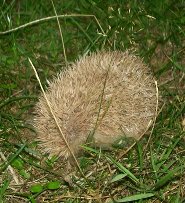 The Western European Hedgehog (Erinaceus europaeus) lives a solitary life from Ireland to South Scandinavia to North-western Russia and from Portugal to Germany and Italy. There are also a few in New Zealand which were brought by settlers. They are 23 to 28 centimeters (9 to 11 inches) long, oval shaped bundles of brown and yellow spines. Adults weigh from 400 to 1,200 grams (14 to 42 ounces) with a short tail of 1.5 to 3 centimeters (0.5 to 1.2 inches). They are commonly seen in meadows and forests but are most often found in orchards, vineyards, gardens, parks and farmland. They also live in urban areas where there are gardens or parks.
The Western European Hedgehog (Erinaceus europaeus) lives a solitary life from Ireland to South Scandinavia to North-western Russia and from Portugal to Germany and Italy. There are also a few in New Zealand which were brought by settlers. They are 23 to 28 centimeters (9 to 11 inches) long, oval shaped bundles of brown and yellow spines. Adults weigh from 400 to 1,200 grams (14 to 42 ounces) with a short tail of 1.5 to 3 centimeters (0.5 to 1.2 inches). They are commonly seen in meadows and forests but are most often found in orchards, vineyards, gardens, parks and farmland. They also live in urban areas where there are gardens or parks.Western European hedgehogs are nocturnal insectivores and eat mostly spiders, worms as well as insects and other invertebrates, but they will also seek eggs and fruit. In captivity they will eat almost anything. They have become popular pets, but they are most often seen in gardens where they are welcomed because they eat the spiders and insects that are considered pests. One tip: do not feed them milk as they cannot digest it!
In cold climates in the north they hibernate from four to seven months and mate in the spring and summer. The young are born helpless without spines which begin to appear a few hours after birth.
Western European hedgehogs are not endangered and are rated Least Concern. However, they are hunted for food and some of their natural enemies are badgers, foxes, dogs, pine martens, large birds of prey and pole cats but this is not considered a danger to the species. When they feel threatened they tuck their heads and legs, which have no spines, under their belly and roll into a ball of bristling spines. They are also vulnerable during hibernation to the gnawing of small rodents.
They can run long distances, are good swimmers and climbers and with their long nose, round body and little black eyes they look cute and often appear as characters in children's stories.
Keywords: nocturnal , hibernate , black
The Northern hedgehog, western european hedgehog is listed as Least Concern (LR/lc), lowest risk. Does not qualify for a more at risk category. Widespread and abundant taxa are included in this category, on the IUCN Red List of Threatened Species
Namings for the western European hedgehog
A young / baby of a western European hedgehog is called a 'hoglet'. The females are called 'sow' and males 'boar'. A western European hedgehog group is called a 'array'.Countries
Austria, Belgium, Croatia, Czech Republic, Denmark, Estonia, Finland, France, Germany, Ireland, Italy, Latvia, Lithuania, Luxembourg, Netherlands, Norway, Poland, Portugal, Russia, Slovenia, Spain, Sweden, Switzerland and United KingdomWestern European hedgehog habitats
Grassland, Shrubland, Subtropical / Tropical Dry Shrubland, Temperate Grassland and Temperate ShrublandSome facts about the
Western European hedgehog
Adult weight : 0.75 kg (1.65 lbs)
Maximum longevity : 12 years
Female maturity :253 days
Male maturity : 253 days
Gestation : 30 days
Weaning : 42 days
Litter size : 2
Litters per year : 2
Weight at birth : 0.015 kg (0.033 lbs)
Weight at weaning : 0.235 kg (0.517 lbs)
Basal metabolic rate : 2 W
Body mass : 1.214 kg (2.6708 lbs)
Temperature : 33.85 °C (92.93 °F)

Custom Search